MUSICAL INSTRUMENTS
Different voices and different instruments produce different tone colors, or timbres. Enormous numbers of devices have been invented for making music over the course of history and across the entire world, and the range of tone colors they can produce is almost endless.
This section will discuss and illustrate the instruments of Western music that make up the orchestra, and a few others. Later, in our Global Perspectives sections, we will meet some instruments from other musical traditions.
Musical instruments can be categorized into four groups: stringed instruments or strings, woodwinds, brass, and percussion. Musical sound, as we know, is caused by rapid vibrations. Each of the four groups of instruments produces sound vibrations in its own distinct way.
Stringed Instruments
Stringed instruments produce their sound by means of taut strings attached to a sound box, a hollow box containing a body of air that resonates (that is, vibrates along with the strings) to amplify the string sound.
The strings themselves can be played with a bow, as with the violin and other orchestral strings; the bow is strung tightly with horsehair, which is coated with a substance called rosin so that the bow grips the strings to make them vibrate. With guitars and harps, the strings are plucked or strummed by the fingers or a small pick. Strings can be plucked on bowed instruments, too, for special effects. This is called pizzicato (pit-
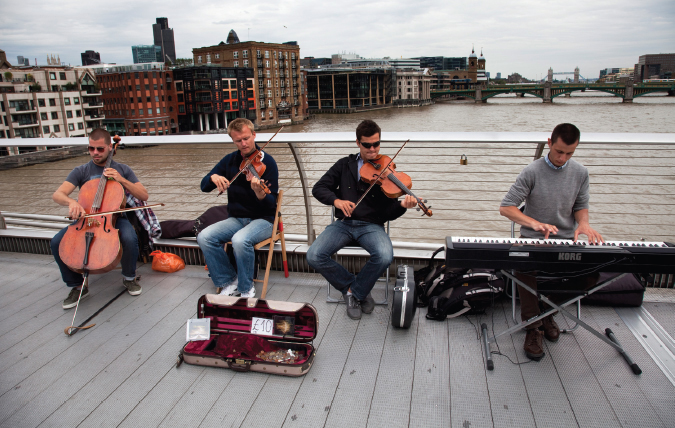
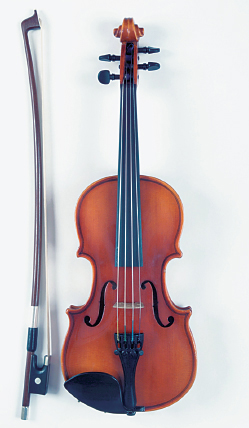
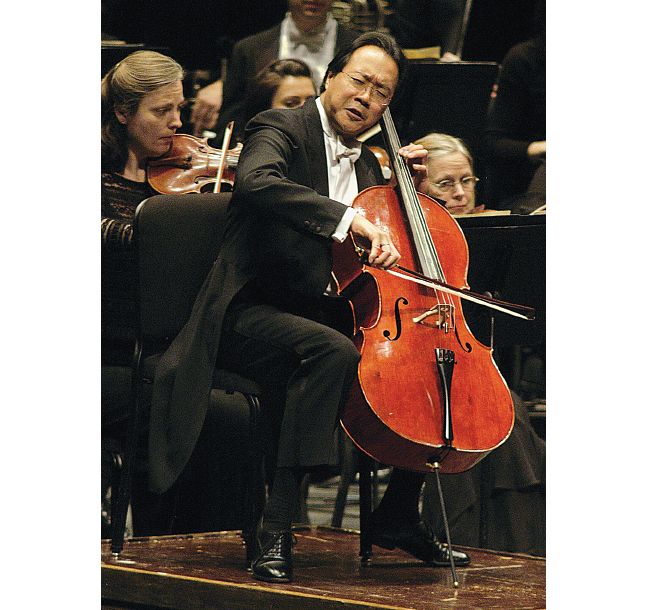
The Violin and Its Family The violin is often called the most beautiful instrument used in Western music. It is also one of the most versatile instruments; its large range covers alto and soprano registers and many much higher pitches. As a solo instrument, it can play forcefully or delicately, and it excels in both brilliant and songlike music. Violinists also play chords by bowing two or more of the four strings at once, or nearly so.
As with a guitar, the player stops the (four) violin strings with a finger — that is, presses the strings against the neck of the violin — to shorten the string length and get different pitches (see the illustrations above and to the right). Unlike a guitar, a violin has no frets, so the player has to learn the exact places to press.
The violin is an excellent ensemble instrument, and it blends especially well with other violins. An orchestra violin section, made up of ten or more instruments playing together, can produce a strong yet sensitive and flexible tone. Hence the orchestra has traditionally relied on strings as a solid foundation for its composite sound.
Like most instruments, violins come in families, that is, in several sizes with different pitch ranges. Two other members of the violin family are basic to the orchestra. The viola is the tenor-
The cello, short for violoncello, is the bass of the violin family. Cellists play seated, with the instrument propped on the floor between their knees. Unlike the viola, the cello has a rich, gorgeous sound in its low register. It is a favorite solo instrument as well as an indispensable member of the orchestra.
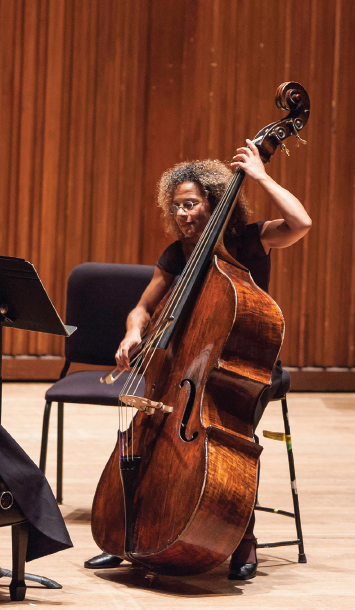
Double Bass Also called string bass or just bass, this deep instrument is used to back up the violin family in the orchestra. (However, in various details of construction the bass differs from members of the violin family; the bass actually belongs to another, older stringed instrument family, the viol family.)
Played with a bow, the double bass provides a splendid deep support for orchestral sound. It is often (in jazz, nearly always) plucked to give an especially vibrant kind of accent and to emphasize the meter.
Harp Harps are plucked stringed instruments with one string for each pitch available. The modern orchestral harp is a large instrument with forty-
Woodwind Instruments
As the name suggests, woodwind instruments were once made of wood. Some still are, while others today are made of metal and even plastic. Sound in these instruments is created by setting up vibrations in the column of air in a tube. A series of precisely spaced holes are bored in the tube, which players open or close with their fingers or with a lever device (a key). In effect this creates columns of different lengths, producing different pitches.
Of the main woodwind instruments, flutes, clarinets, and oboes have approximately the same range. All three are used in the orchestra because each has a quite distinct tone color, and composers can obtain a variety of effects from them. It is not hard to learn to recognize and appreciate the different sounds of these woodwinds.
The Flute and Its Family The flute is simply a long cylinder, held horizontally; the player sets the air vibrating by blowing across a side hole. The flute is the most agile of the woodwind instruments and also the gentlest. It nonetheless stands out clearly in the orchestra when played in its high register.
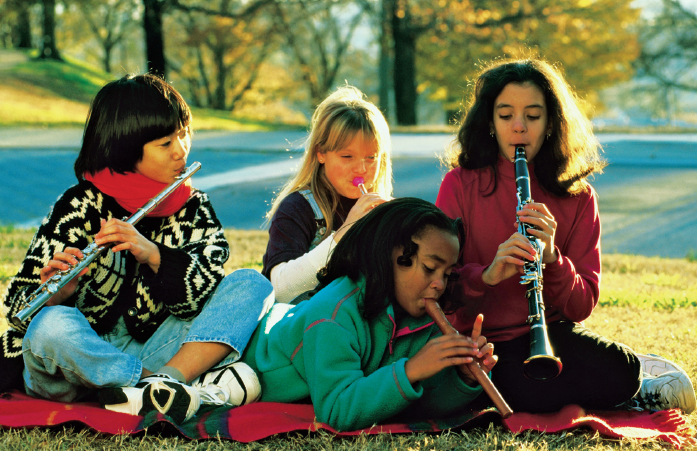
The piccolo, the smallest, highest member of the flute family, adds special sparkle to band and orchestral music. The alto flute and bass flute — larger and deeper flutes — are less frequently employed.
The recorder, a different variety of flute, is blown not at the side of the tube but through a special mouthpiece at the end. Used in older orchestral music, the recorder was superseded by the horizontal, or transverse, flute because the latter was stronger and more agile. In the late twentieth century recorders made a comeback for modern performances of old music using reconstructed period instruments. The instrument is also popular (in various family sizes) among musical amateurs today. The recorder is easy to learn and fun to play.
Clarinet The clarinet is a slightly conical tube made, usually, of ebony (a dark wood). The air column is not made to vibrate directly by blowing into the tube, as with the flute. The player gets sound by blowing on a reed — a small piece of cane fixed at one end — in much the same way as one can blow on a blade of grass held taut between the fingers. The vibrating reed vibrates the air within the clarinet tube itself.
Compared to the flute, the clarinet sounds richer and more flexible, more like the human voice. The clarinet is capable of warm, mellow tones and strident, shrill ones; it has an especially intriguing quality in its low register.
The small E-
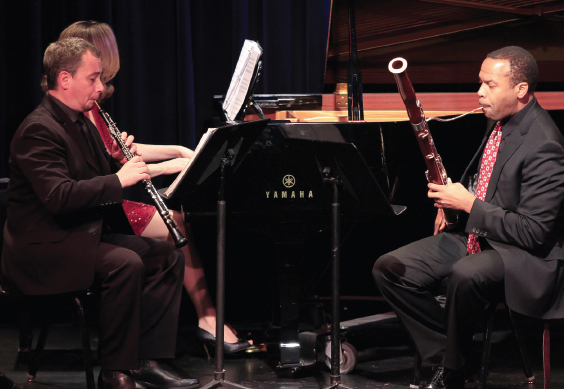
Oboe The oboe also uses a reed, like the clarinet, but it is a double reed — two reeds lashed together so that the air must be forced between them. (You can see the effort involved in the picture to the right.) This kind of reed gives the oboe its clearly focused, crisply clean, and sometimes plaintive sound.
The English horn is a larger, lower oboe, descending into the viola range. It is often called by the French equivalent, cor anglais; in either language, the name is all wrong, since the instrument is not a horn but an oboe, and it has nothing to do with England.
Bassoon The bassoon is a low (cello-
The contrabassoon, also called the double bassoon, is a very large member of the bassoon family, in the double bass range.
Saxophone The saxophone, invented by the Belgian instrument maker Adolphe Sax, was first used around 1840 in military bands. The instrument is sometimes included in the modern orchestra, but it really came into its own in jazz. Saxophones are close to clarinets in the way they produce sound. Both use single reeds. Since the saxophone tube is wider and made of brass, its tone is even mellower than that of the clarinet, yet at the same time more forceful. The long saxophone tube has a characteristic bent shape and a flaring bell, as its opening is called.
Most common are the alto saxophone and the tenor saxophone. But the big family also includes bass, baritone, and soprano members.
Brass Instruments

The brass instruments are the loudest of all the wind instruments because of the rather remarkable way their sound is produced. The player’s lips vibrate against a small cup-
Trumpet The trumpet, highest of the main brass instruments, has a bright, strong, piercing tone that provides the ultimate excitement in band and orchestral music alike. Pitch is controlled by three pistons, or valves, that connect auxiliary tubes with the main tube or disconnect them, so as to lengthen or shorten the vibrating air column.
French Horn The French horn has a lower, mellower, thicker tone than the trumpet. It is capable of mysterious, romantic sounds when played softly; played loudly, it can sound like a trombone. Chords played by several French horns in harmony have an especially rich, sumptuous tone.
Trombone The tenor trombone and the bass trombone are also pitched lower than the trumpet. The pitch is controlled by a sliding mechanism (thus the term slide trombone) rather than a valve or piston, as in the trumpet and French horn.
Less bright and martial in tone than the trumpet, the trombone can produce a surprising variety of sounds, ranging from an almost vocal quality in its high register to a hard, powerful blare in the low register.
Tuba The bass tuba is typically used as a foundation for the trombone group in an orchestra. It is less flexible than other brass instruments. And like most other deep bass instruments, it is not favored for solo work.
Other Brass Instruments All the brass instruments described so far are staples of both the orchestra and the band. Many other brass instruments (and even whole families of instruments) have been invented for use in marching bands and have then sometimes found their way into the orchestra.
Among these are the cornet and the flügelhorn, both of which resemble the trumpet; the euphonium, baritone horn, and saxhorn, which are somewhere between the French horn and the tuba; and the sousaphone, a handsome bass tuba named after the great American bandmaster and march composer John Philip Sousa.
Finally there is the bugle. This simple trumpetlike instrument is very limited in the pitches it can play because it has no piston or valve mechanism. Buglers play “Taps” and military fanfares, and not much else.
Percussion Instruments
Instruments in this category produce sound by being struck (or sometimes rattled, as with the South American maraca). Some percussion instruments, such as drums and gongs, have no fixed pitch, just a striking tone color. Others, such as the vibraphone, have whole sets of wooden or metal elements tuned to regular scales.
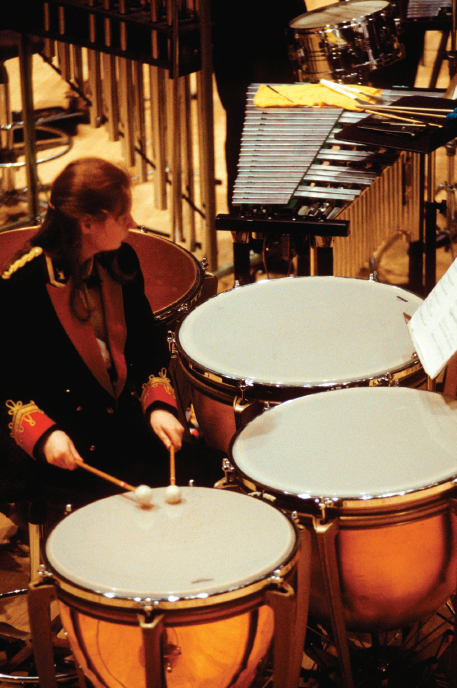
Timpani The timpani (or kettledrums) are large hemispherical drums that can be tuned precisely to certain low pitches. Used in groups of two or more, timpani have the effect of “cementing” loud sounds when the whole orchestra plays, so they are the most widely used percussion instruments in the orchestra.
Timpani are tuned by tightening the drumhead by means of screws set around the rim. During a concert, one can often see the timpani player, when there are rests in the music, leaning over the drums, tapping them quietly to hear whether the tuning is just right.
Pitched Percussion Instruments Pitched percussion instruments are scale instruments, capable of playing melodies and consisting of whole sets of metal or wooden bars or plates struck with sticks or hammers. While they add unforgettable special sound effects to many compositions, they are not usually heard consistently throughout a piece, as the timpani are.
These instruments differ in their materials:
The glockenspiel has small steel bars. It is a high instrument with a bright, penetrating sound.
The xylophone has hardwood plates or slats. It plays as high as the glockenspiel but also lower, and it has a drier, sharper tone.
The marimba, an instrument of African and South American origins, is a xylophone with tubular resonators under each wooden slat, making the tone much mellower.
The vibraphone has metal plates, like a glockenspiel with a large range, and is furnished with a controllable electric resonating device. This gives the “vibes” an echoing, funky quality unlike that of any other instrument.
Also like the glockenspiel, the celesta has steel bars, but its sound is more delicate and silvery. This instrument, unlike the others in this section, is not played directly by a percussionist wielding hammers or sticks. The hammers are activated from a keyboard; a celesta looks like a miniature piano.
Tubular bells, or chimes, are hanging tubes that are struck with a big mallet. They sound like church bells.
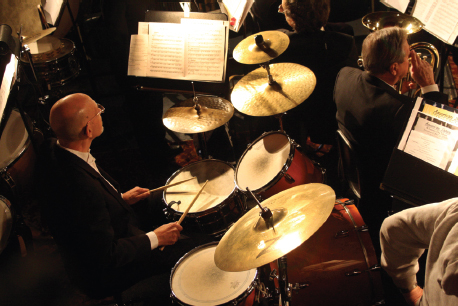
Unpitched Percussion Instruments In the category of percussion instruments without a fixed pitch, the following are the most frequently found in the orchestra.
Cymbals are concave metal plates, from a few inches to several feet in diameter. In orchestral music, pairs of large cymbals are clapped together to support climactic moments in the music with a grand crashing sound.
The triangle — a simple metal triangle — gives out a bright tinkle when struck.
The tam-
The snare drum, tenor drum, and bass drum are among the unpitched drums used in the orchestra.
The Orchestra
The orchestra has changed over the centuries, just as orchestral music has. Bach’s orchestra in the early 1700s was about a fifth the size of the orchestra required today. (See pages 108, 157, and 227 for the makeup of the orchestra in various historical periods.)
So today’s symphony orchestra has to be a fluid group. Eighty musicians or more will be on the regular roster, but some of them sit out some of the pieces on many programs. And freelancers have to be engaged for special compositions in which composers have imaginatively expanded the orchestra for their own expressive purposes. A typical large orchestra today includes the following sections, also called choirs.
Strings: about thirty to thirty-
Woodwinds: two flutes and a piccolo, two clarinets and a bass clarinet, two oboes and an English horn, two bassoons and a contrabassoon.
Brass: at least two trumpets, four French horns, two trombones, and one tuba.
Percussion: one to four players, who between them manage the timpani and all the other percussion instruments, moving from one to the other. Unlike the violins, for example, the percussion instruments seldom have to be played continuously throughout a piece.
There are several seating plans for orchestras; which is chosen depends on at least two factors. The conductor judges which arrangement makes the best sound in the particular hall. And some conductors feel they can control the orchestra better with one arrangement, some with another. One such seating plan is shown below.
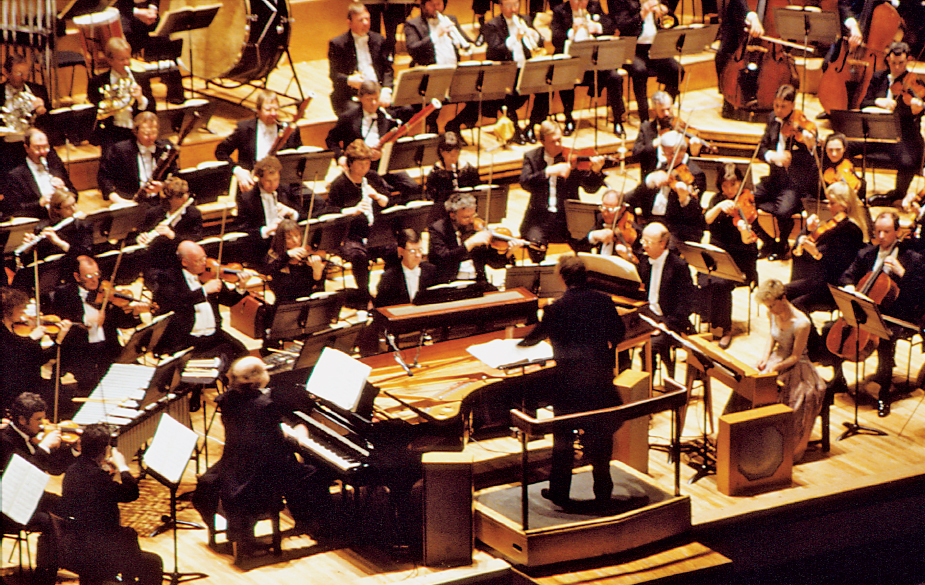
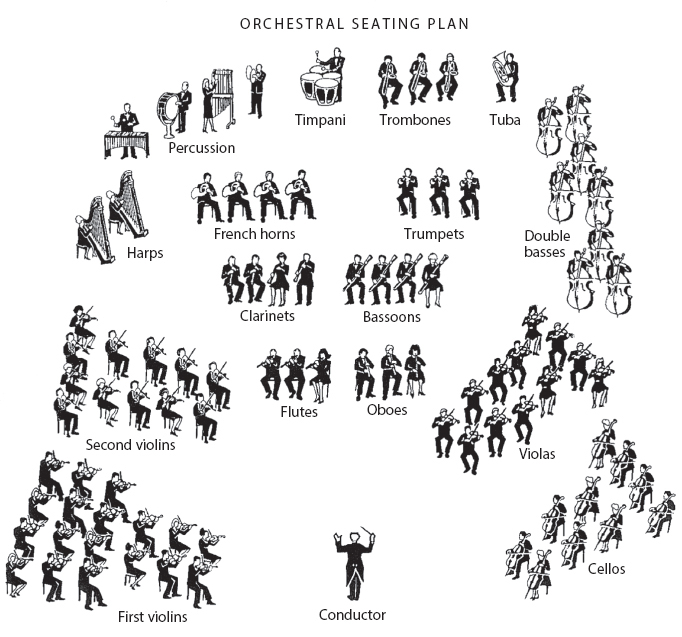
Keyboard Instruments
Though most orchestras today include a pianist, the piano is a relatively new addition to the symphony orchestra. In earlier times, the orchestra regularly included another keyboard instrument, the harpsichord.
The great advantage of keyboard instruments, of course, is that they can play more than one note at a time. A pianist, for example, can play a whole piece without requiring any other musicians at all. Consequently the solo music that has been written for piano, harpsichord, and organ is much more extensive and important than (accompanied) solo music for other instruments.
Piano The tuned strings of a piano are struck by felt-
The hammer must strike the string and then fall back at once, while a damping device made of felt touches the string to stop the sound instantly. All this must be done so fast that the pianist can play repeated notes as fast as the hand can move. Also, many shades of loudness and softness must lie ready under the player’s fingers. This dynamic flexibility is what gave the piano its name: piano is short for pianoforte, meaning “soft-
The list of virtuoso pianists who were also major composers extends from Mozart through Frédéric Chopin to Sergei Rachmaninov. In the nineteenth century, the piano became the solo instrument. At the same time, nearly every middle-
Harpsichord The harpsichord is an ancient keyboard instrument that was revived in the 1900s for the playing of Baroque music, in particular.
Like the piano, the harpsichord has a set of tuned strings activated from a keyboard, but the action is much simpler. There is no damping, and instead of hammers striking the strings, the key lifts up a quill that plucks the string. This means, first, that the tone is brittle and ping-
Harpsichord makers compensated for this limitation in dynamics by adding one or two extra full sets of strings, controlled by an extra keyboard. One keyboard could be soft, the other loud. A mechanism allowed the keyboards to be coupled together for the loudest sound of all.
In spite of its brittle tone and its lack of flexibility in dynamics, the harpsichord can be a wonderfully expressive instrument. Good harpsichord playing requires, first and foremost, great rhythmic subtlety.
Another keyboard instrument of early times, the clavichord, has the simplest action of all. Its tone is much too quiet for concert use.
Organ Called “the king of instruments,” the pipe organ is certainly the largest of them (see page 147). This instrument has to provide enough sound to fill the large spaces of churches and cathedrals on a suitably grand scale. The organ has a great many sets of tuned pipes through which a complex wind system blows air, again activated from a keyboard. The pipes have different tone colors, and most organs have more than one keyboard to control different sets of pipes. A pedal board — a big keyboard on the floor, played with the feet — controls the lowest-
Each set of tuned pipes is called a stop; a moderate-
The organ is not a member of the orchestra, but because the grandest occasions call for orchestra, chorus, vocal soloists, and organ combined (e.g., Handel’s Messiah at Christmastime; see page 142), a major symphony hall has to have its organ — usually an imposing sight.
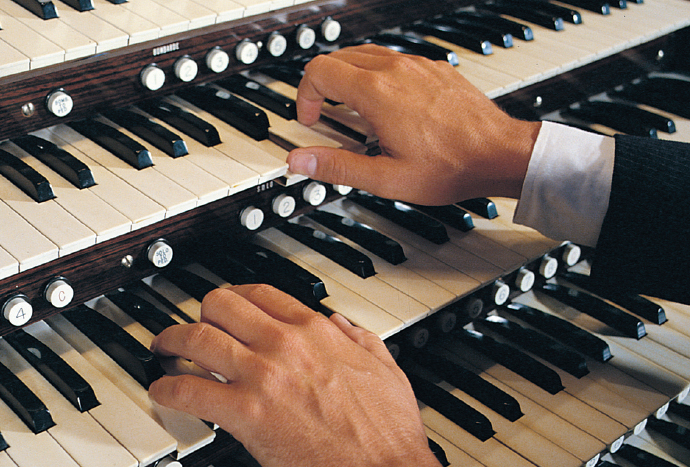
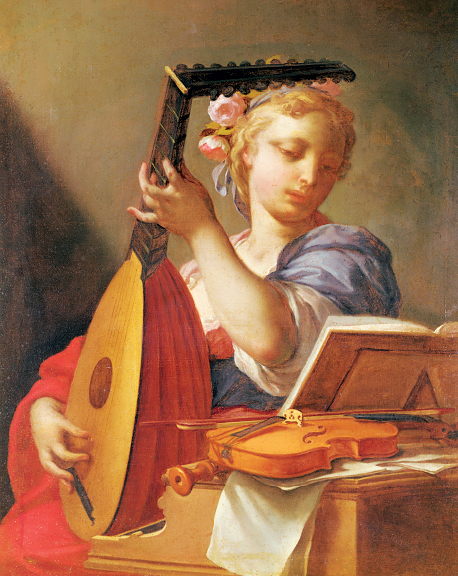
ElectronicKeyboard Instruments Today keyboard or organ generally means an electronic instrument. Synthesizers simulate the sound of organs, pianos, and harpsichords — and many other sounds as well.
Modern concert music, from the 1960s on, has occasionally used electronic keyboards. On the whole, however, synthesizers have been used more to compose concert music than to play it. And of course electronic keyboards play major roles in today’s popular music.
Plucked Stringed Instruments
Plucked stringed instruments figure much less in art music of the West than in Asian countries such as India and Japan, as we shall see. One exception is the orchestral harp; see above. The acoustic guitar and the mandolin are used very widely in Western popular music, but only occasionally in orchestras.
However, a now-
Like keyboard instruments, plucked stringed instruments have been revolutionized by electronic technology. Electric guitars dominate rock music, though they have only occasionally found their way into concert music.